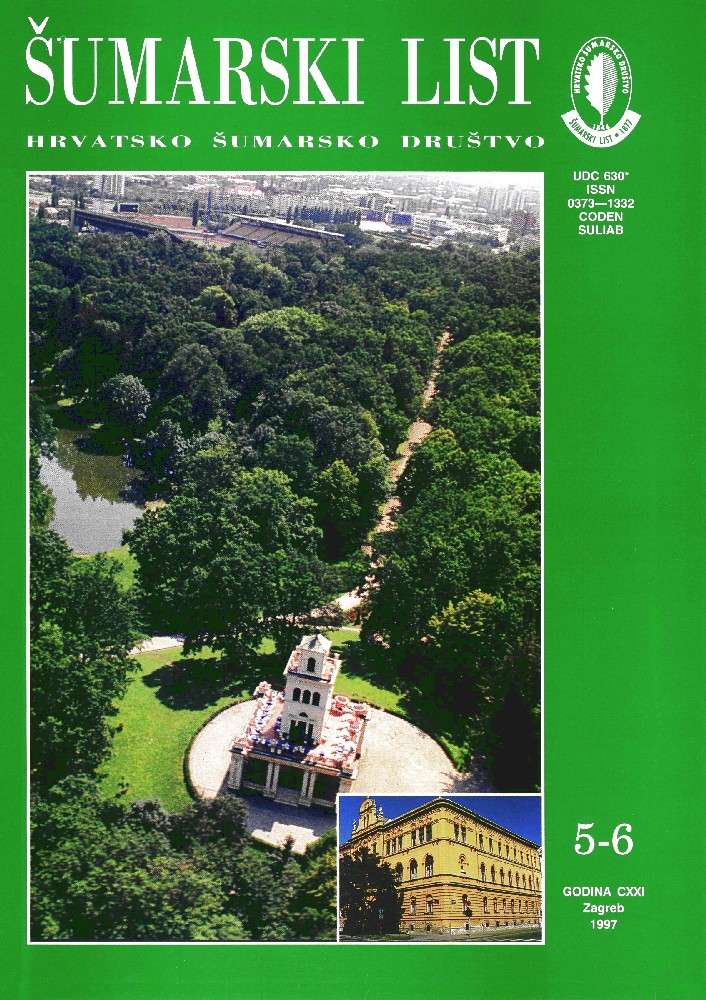
broj: 5-6/1997
pdf (31,9 MB) |
|
||||||||||||||
| IZVORNI ZNANSTVENI ČLANCI | ||
| Pintarić, K. | UDK 630* 231+236.001 (Pinus nigra Arn.) | |
| The Analysis of the Structure and Quality of the Natural Black Pine Young Growth pdf HR EN | 215 | |
| Matić, S., Prpić, B. | UDK 630* 272+249:630* 652+907.001 | |
| The Programme of Tending and Maintenance, the Ecological and Social Functions of the Zagreb Park Forest pdf HR EN | 225 | |
| Bojanin, S., Krpan, A. P. B. | UDK 630* 312+379:630* 419.001 | |
| Adjustement of the Skidding Technology to Forest Protection pdf HR EN | 243 | |
| Perić, Z. | UDK 630* 165.001 (Larix decidua Mill.) | |
| Interclonal and Clonal Differences in a Seed Orchard of European Larch (Larix decidua Mill.) near Bjelovar pdf HR EN | 253 | |
| Jurković, M., Jurković-Bevilacqua, B. | UDK 630* 175.272:181.2.001 | |
| The Contribution to the Introduction and Acclimatization of Exotic Woody Plants - Deciduous Trees in the Parks of Zagreb pdf HR EN | 269 | |
| PREGLEDNI ČLANCI | ||
| Đurasović, P. | UDK 630* 279:232.1 | |
| The Introduction of Exotic Trees and Shrubs in the Region of Dubrovnik pdf HR EN | 277 | |
| Summary: No reliable data are available about the introduction of foreign trees and bushes into the Dubrovnik area in the period between the foundation of the city in 7th century until the early 15th century. The first written document on the introduction of woody exotic plants date from 1440, when Philip de Diversis in his "Description of Dubrovnik" mentions oranges (Citrus sinensis L./Pers.) and laurels (Laurus nobilis L.), in the small cloister park within St. Francis monastery in Dubrovnik: "In the middle of the cloister, in a small garden with laurels and oranges, grow vegetables". At the end of 15th century, in the year 1494, a Milan nobleman and clerk Pietro Casola, stopping in Dubrovnik on his way to Jerusalem, praised the beauty of the Dubrovnik parks where he saw oranges and laurels. The old Gučetić park in Trsteno, today the Arboretum of the Croatian Academy of Sciences and Arts in Zagreb, was established in 15th century (earliest records dating December 10, 1494), plays a significant role in the introduction and acclimatization of exotic trees and bushes in the Dubrovnik area, Croatia and this part of Europe. In 1515, the parish priest Don Luka Diodati Božidarović recorded that orange trees were planted near the parish church in Trsteno. In 1530, a Venetian Benedetto Ramberti described Gruž in his travels as a place with parks füll of sweet oranges, lemons (Citrus limon L./Burm.), cedars (Cedrus sp.) and fruit-trees of most different species. In the 16th century, a Benedictine monk Mavro Vetranović from Dubrovnik sent oleanders (Nerium oleander L.) and cypresses (Cupressus sp.) to the noblemen Petar Hektorovicfor his castle and park Tvrdalj. The island of Lokrum has also been a distinguished location of the introduced and adapted woody exotic plants, especially since the middle of the 19th century, when Maximilian Habsburg bought the island in 1859, establishing a park where exotic trees and bushes were introduced from the distant countries of the south: Brazil, Canary islands, India and China. Now, in the late 20th century, the enthusiasm for bringing exotic trees and bushes to the Dubrovnik area has been supported by the Croatian Academy Arboretum, established in Trsteno in 1948, and the Botanical gardens of the Island of Lokrum, established in 1960. In 1991 and the following year, Serbs and Montenegrians supported by the Yugoslav army committed an unprecedented crime by destroying the natural environment of the Dubrovnik area, throwing phosphoric bombs from the air, and incendiary bombs from the war vessels and land, devastating forests and parks, olive-trees and vineyards, fields and other precious vegetation. Arboretum vanished in a disastrous fire. More than 80 of its vegetation is lost, with more than 10 thousand forest trees, nurseries with over 20 thousand seedlings of exotic trees and bushes, and more than 200 woody exotic species. Though shelled many times, the Island of Lokrum did not catch fire. By the end of 1994, the new status of the exotic trees and bushes was estimated at 600 species, and in the Trsteno Arboretum about 300. | ||
| STRUČNI ČLANCI | ||
| Nekvapil, N. | UDK 630* 628 | |
| Forest Management of the "Bastaji Forest - Krivaja - Klisa" pdf HR EN | 291 | |


